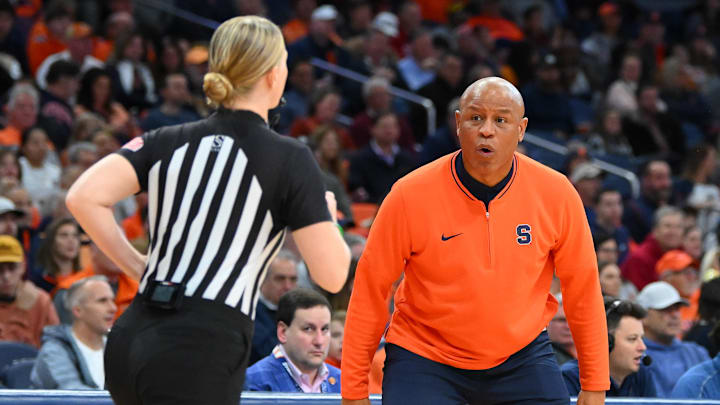Through the first three games, Syracuse basketball is undefeated but has looked less than stellar. The Orange have had to fight and claw to wins over LeMoyne, Colgate, and Youngstown State, each of which could have been a loss.
As of this writing, Syracuse is ranked 106th in KenPom rankings behind Yale, Arkansas State, and Georgia Tech, each with a loss. That is a striking regression from the start of the year, when Red Autry's team checked in at 68th.
While Cuse has avoided the harmful Q4 losses against mid-majors that should be overmatched, the level of competition is quickly set to increase. On Thursday in Brooklyn, Syracuse will take on a 3-1 Texas team ranked 24th in KenPom and coming off a round of 32 appearance a season ago.
The next day, Cuse will play either Texas Tech or St. Joseph's as a part of the UKG Legends Classic. After playing Cornell on November 27th, games at Tennessee on December 3rd and Notre Dame on December 7th are scheduled. This five-game stretch will quickly determine a lot of what this Syracuse team can be.
The question is, why has Syracuse played so poorly? I think there are three main causes: poor defense from guards, transition defense, and shooting. Let's see how they can be improved.
Examining Syracuse basketball's early-season issues and how to address them.
Problem 1: Defense from guards
Syracuse guards, particularly Jaquan Carlos and JJ Starling, have had numerous struggles on the defensive end. They have frequently gotten blown by to the basket for easy layups. It also hurts that Syracuse doesn't have a rim protector, as 6'11", 265-pound center Eddie Lampkin Jr. has only one block. Either way, LeMoyne, Colgate, and Youngstown State guards, which are less talented, shouldn't be able to get by a former four-star transfer and five-star high school recruit.
What's the solution? It's not a 2-3 zone, I think that will only make the defensive problems worse based on the roster and personnel. Carlos has been particularly poor on defense and I think he'll be getting fewer minutes in favor of Starling at the point with Elijah Moore and Lucas Taylor stepping in at the two guard. Taylor has been an improvement on the defensive end and I think Moore, a top-100 four-star freshman, will grow into his role as the season goes on.
While Moore and Taylor should improve the blow-bys, I think the guard play will struggle all year. Again, if mid-major guards are killing Syracuse like that, what's going to happen against better teams? Additionally, Starling is a net negative on defense but will have to play a lot because of his offensive upside.
Problem 2: Transition defense
If you've watched a Syracuse game, you've seen how many easy transition points the team gives up. The numbers back that up, and after the Colgate game, Syracuse was ahead of only Villanova among high-major teams in transition defense, according to CBBAnalytics and Sam Federman of Troy Nunes is an Absolute Magician.
He goes deeper into the Orange transition defense in his article and it's ugly. LeMoyne only had eight fast break points, but Colgate had 22. The number decreased to 14 against Youngstown State but that's still not where it needs to be.
My opinion is that Syracuse defenders are getting caught flat-footed way too often and letting quick guards with a head of steam get by for layups. Additionally, wing defenders aren't back fast enough and giving up open three-point shots. It's not an individual problem either - almost every Orange player has given up easy points in transition.
Where does the Orange go from here? I think the transition defense will improve, and the coaching staff will make it a point of emphasis during practice. A season ago, Synergy Sports put Syracuse in the 62nd percentile - slightly above average - in transition defense.
When all is said and done, I think the Orange will improve to around the 45th percentile. There isn't much to transition defense other than communication and effort and Syracuse certainly has a talented enough team along with Red Autry's coaching to make it work.
Problem 3: Shooting
Through the first three games, Syracuse is shooting 46% from the field, 25.4% from three, and an appalling 63.6% from the free-throw line. Those numbers are good for 11th, 17th, and 18th, respectively, in the 18-team ACC, numbers which are all down from last season.
At a more individual level, Chris Bell is shooting 40.5% from the field and 22.2% from three. He shot 43.4% and 42% a year ago. Jaquan Carlos is shooting 18.8% from the field, 20% from three, and 50% from the free-throw line; he shot 41.3% on field goals, 34.4% on three-pointers, and 50% at the free-throw line for Hofstra last year. Finally, Eddie Lampkin Jr. is 40% at the free-throw line vs. 66.1% at Colorado a year ago.
There are some improvements, however. JJ Starling is averaging 55.6% from the field after being 45.8% a year ago, but that's the most notable one. I believe Syracuse will regress to the mean and improve their shooting numbers, especially at the free-throw line.
I can't believe they will sustain shooting 63.6% at the line and wonder if it's just a mix of bad luck and newcomers not used to shooting in a football stadium. Additionally, the 25.4% number from three will not last. Chris Bell is a streaky shooter, and he will find his shot, among others. However, I do think the 46% from the field is roughly where the Orange will end up, give or take a percentage or two up.
